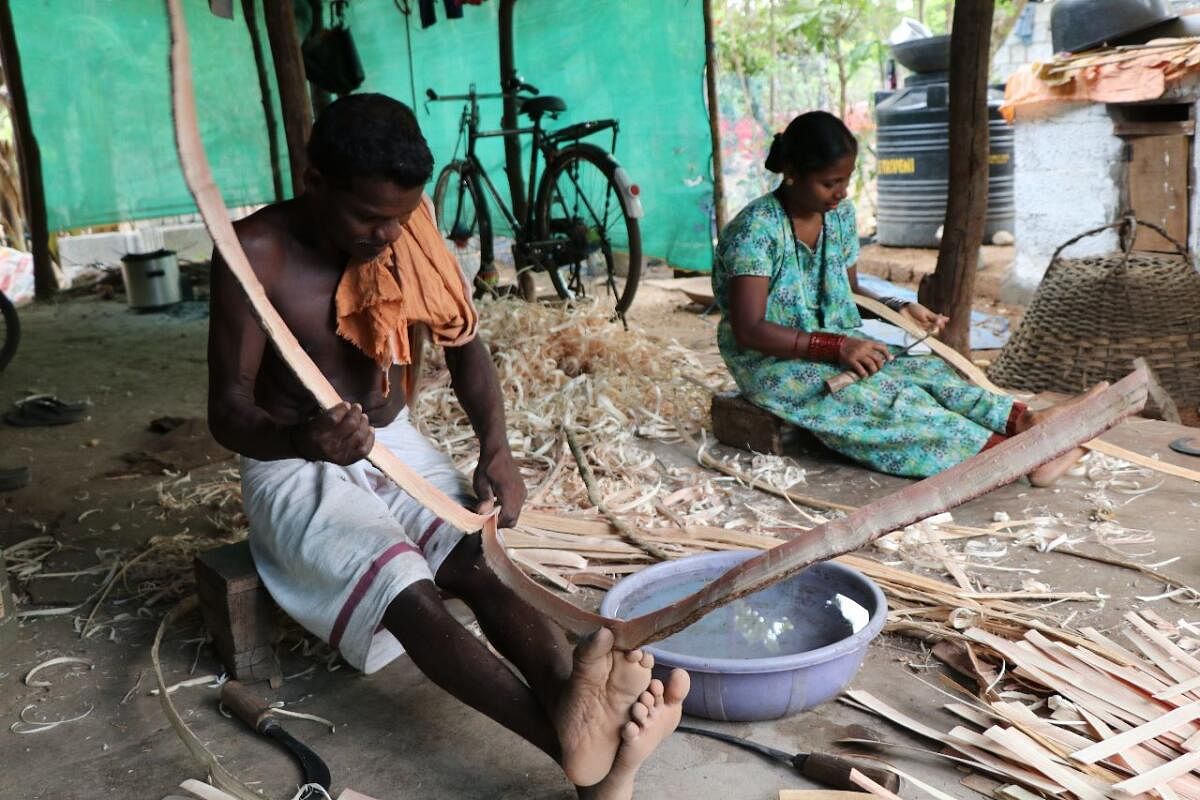
A handful of families in Udupi district are working to sustain the distinctive practice of weaving baskets. Babu (50) and Ammi (42), hailing from Kadthala, a small village in Karkala taluk, have adopted the occupation of basket weaving, inherited from their ancestors. The family has been involved in making handicrafts over the past twenty years. They make baskets using natural materials gathered from the forests.
“Basket weaving is an important tradition in our culture. I was determined to preserve it in this rapidly evolving world. So, I learned this skill from my parents,” says Babu.
The couple has embraced basket weaving as their primary means of earning a living. The raw materials used for traditional basketry are not easily accessible. So Babu and Ammi have to venture into remote forests to gather raw materials.
Basket weaving has always been part of her regular routine, says Ammi. The couple also goes to the forest together to gather the materials.
Each time, they collect a supply that can last them about a week. Once the materials are gathered, they begin the initial process of clearing out useless particles and scraping the tree branches of the ‘enger buru’ and ‘mader buru’ plants (Tulu names of a particular vine found commonly in Udupi and Dakshina Kannada districts).
To ensure the flexibility and quality of the materials, they regularly dip the scraped branches in water, keeping them hydrated throughout the weaving process.“The scraped branches become flexible and are easy to weave when they are plunged into the water. This also helps in avoiding breakage. The branches are then weaved,” Babu explains.
Along with the baskets, Babu and Ammi are also adept at weaving lanterns. They vend the baskets and other artefacts to a reseller.
The Koraga community
Most people inhabiting this region belong to the Koraga Community. The tradition of basket weaving has grown rare here, over time. Some sew the baskets as a part-time job and dedicate the rest of their time to regular jobs.
"We do not receive any support from the government," says Babu.
The Tribal Welfare Department of Udupi district has recently introduced specific benefits for basket weavers. "We have initiated a scheme to provide basket weavers in the district with a subsidy of Rs 10,000. A call for applications is made every year, allowing weavers to apply for subsidies,” says Doodpeer, project coordinator officer of the Tribal Welfare Department, Udupi District.
Customer connection
The handwoven baskets made by Babu and Ammi have not gained much traction in the market. “Occasionally, we receive inquiries for basket orders and other handmade items like Diwali lanterns. However, we do not receive a large number of customers consistently,” says Ammi.
At times, they get orders from distant places. But due to a lack of access to transport facilities, Babu and Ammi are unable to deliver the baskets to them.
Recently, Babu and Ammi got to display and sell their work at an art expo held in Udupi. “The fascinating works made by Babu and Ammi caught my attention. Their hard work is purely out of love for their culture, to keep the traditional art form alive”, says Shilpa Kulal, a visitor and customer.
The main motive of the art expo is to create awareness among artisans and educate them about various modern technologies, says Purushotham Adve, an artist and the managing trustee of Prachi Samsthe, the NGO which organised the event.
“We also provide an identity card for the artisans. This card helps them get certain benefits,” Adve adds.
Despite the obstacles faced by the family, Babu says he will always value the art of basket weaving, the tradition of his forefathers.
“The basket makers of the Koraga Tribe are nature lovers. They do not have access to modern technologies, so they work hard to manually collect materials. Their sole focus is to pass on the tradition of basket weaving to younger generations”, says Madhumala, a professor and researcher.